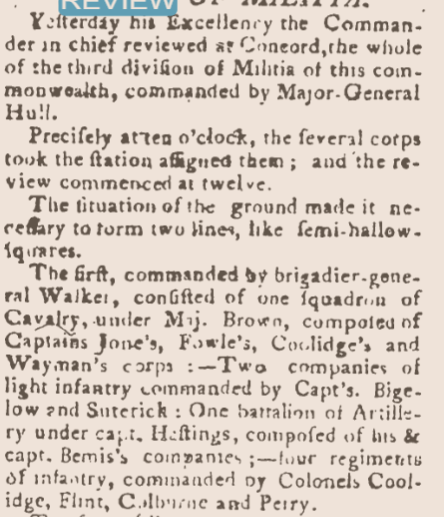Wait....WHO Came to Our Militia Muster?!?
- Alex C.
- Feb 1, 2018
- 4 min read
Following the American Revolution, service in the militia was still compulsory. In fact, during the early 1790s, both the United States and Massachusetts governments passed a series of revised laws outlining the expectations and requirements of service in the militia. The two acts generally mirrored earlier militia regulations, but Massachusetts’ also included a few updates. For example, the 1793 Militia Act was modified to include rifles, a weapon virtually unknown in the state prior to the Revolutionary War. “Every Non- Commissioned Officer & private of the In- Necessary fantry shall constantly keep himself provided with a good equipment. Musquet, with an iron or steel rod ; a sufficient bayonet & belt, —two spare flints, "a priming wire & brush & a knapsack ; — a cartridge box or pouch with a box therein to contain not less than twenty four cartridges suited to the bore of his Musquet ; — each cartridge to contain a proper quantity of powder & ball, or with a good rifle, knapsack, shott-pouch, powder horn, twenty balls suited to the bore of his rifle, & a quarter of a pound of Powder.”

Period sources suggest that following the Revolution, many militia companies only gathered seasonally to drill. Likewise, regiments only assembled about once a year to perform basic military maneuvers.
By the beginning of the 19th Century, militia musters had evolved into a social gathering with a carnival like atmosphere. The presence of “independent” militia companies only added to the spectacle. These semi private organizations more closely resembled a social club for the local elite than a military unit. Almost always, Massachusetts independent companies were well equipped and uniformed. Their presence often turned musters into fashion shows.

Sarah Smith Emery was born in Newbury, Massachusetts in 1787. As we alluded to in a previous post, Emery and her husband dominated the Newburyport smuggling trade during the War of 1812. In 1879 her daughter published Sarah’s memoirs, entitled Reminiscences of a Nonagenarian.
Emery includes an account of a regimental level drill she observed in the mid to late 1790s. According to her description, the units present were Newbury and Newburyport militia units and local independent companies. However, the event also attracted a variety of unusual and questionable characters, including shady merchants and . . . ummm . . . prostitutes.
“One of the great institutions of those days was the spring and fall trainings. There were company musters at the training field on the main road in May and September, and a regimental review at the Plains some time in autumn. The officers of these militia companies alone wore uniforms, the privates mostly turned out in their Sunday suits. The musket in those days was fired by a flint, the spark from which lighted the priming in a little external pan connected with the interior charge through a small vent. A priming wire about the size of a common knitting needle, and a little brush two inches long, which hung by a brass chain to the belt, were used to keep the vent clear and the pan clean. These training days were the occasion for a general frolic, especially the reviews. General trainings drew a motley crowd, vendors of all sorts of wares, mountebanks and lewd women; a promiscuous assemblage, bent upon pleasure. Beyond the lines there was always much carousing and hilarious uproar. Many customs were then in vogue, now obsolete in military circles, such as firing at the legs of an officer at his appointment to test his courage, and firing a salute before the residence of a new officer at sunrise on the morning of training day. Of course the recipient of these honors was expected to give a treat. Many a poor fellow became “onsteady” before the day had far advance, and more were hors-du-combat ere it had closed. Accidents often occurred. One officer, from the careless loading of a gun, received a severe wound in the leg, and Mr. Oliver Pillsbury had several lights in his new house broken at a salute in honor of his attaining a lieutenancy. At this review there was a large cavalry company, including members from both Newburyport and Newbury. Newburyport had one uniformed company, the artillery. I very well remember how imposing they looked to my childish eyes as they marched onto the muster field at the plains, to the music of fife and drum, with waving flag, and followed by their field pieces. The regimental bands were then unknown. The foot soldiers marched to the fife and drum, the cavalry to the notes of the bugle. Colby Rogers was trumpeter for the troops for many years. The Governor and staff and many distinguished guests were present n the great day I have recalled. A public dinner was given and the festivities were closed by a grand ball in the evening. I was about seven years old when this militia system was organized, and well do I remember the sensation produced by the officers of our company presenting themselves at meeting, the Sunday preceding the fall training, in their new uniforms.”























